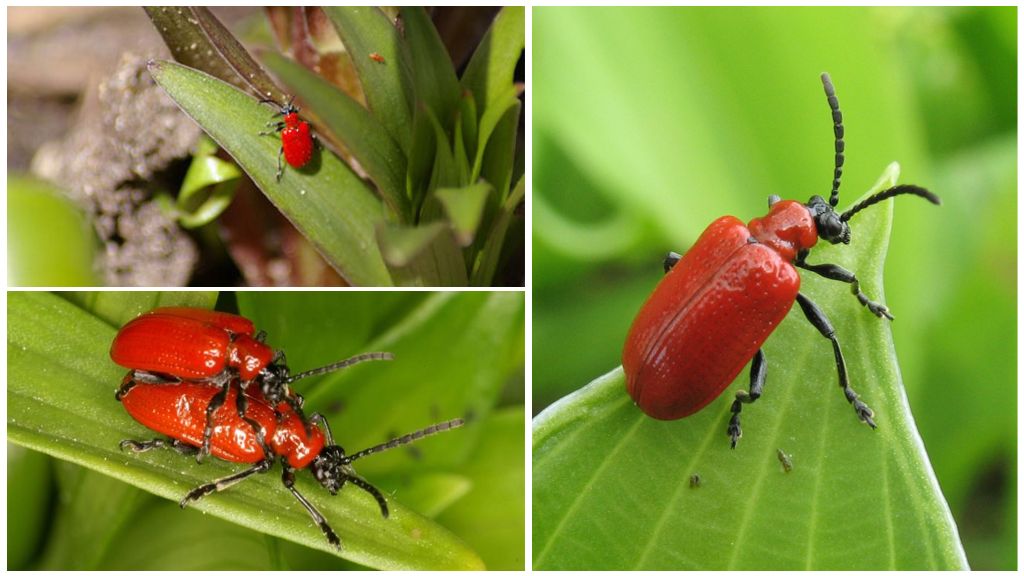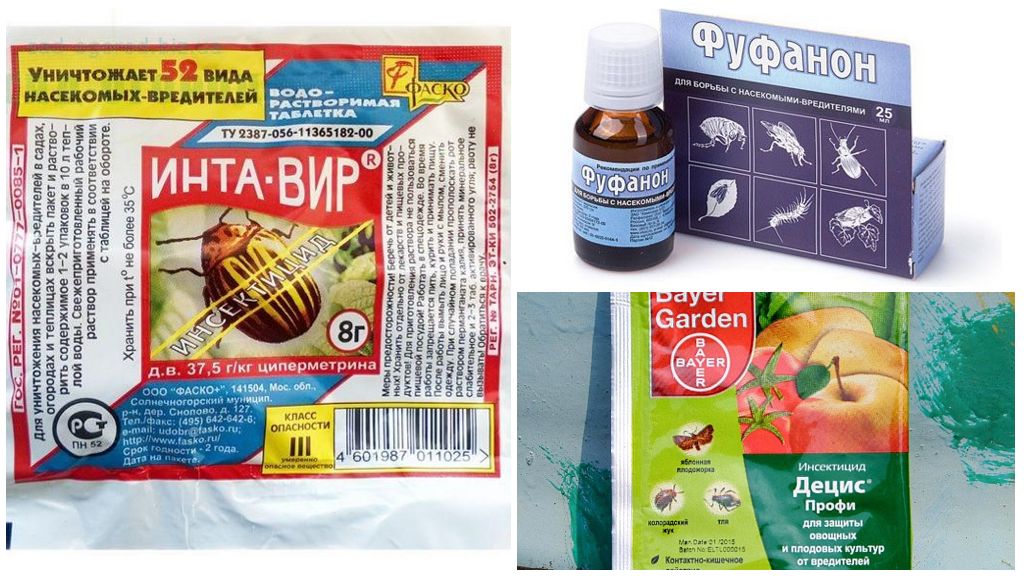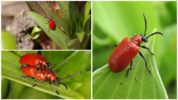- Lily beetle
- Pest Insecticides
- Folk remedies for red beetles
Red beetle is a malicious pest of lilies, popularly known as fireman, squeak. It does not bite, does not poison, does not emit an unpleasant odor, is safe for humans. In case of danger to his own life, he falls to the ground, presses his paws. The red bug belongs to the family of leaf beetles, eats the green part of plants, becomes a provocateur of fungal, bacterial infections.
Who eats lilies in the garden
In our area, pests of two species live - onion red beetles, lily or lily. Outwardly similar, they lead an identical lifestyle. The bright red color resembles the color of a fire engine, because of this he was called a firefighter. In dangerous situations, the insect begins to make sounds similar to crackling. Due to this feature, they are called squeaks, crackles, ratchet.
Medium sized lily beetle - up to 1 cm in length. The body is elongated, the majority occupies the abdomen, the head is small, black, lowered down. Long twisted mustache, 3 pairs of short, tenacious legs, ending in claws. The chest is small. The body is covered with a strong shell. The wings are well developed, insects fly long distances in search of food. A photo of the Piskun bug is presented below.
On a note!
Larvae are caterpillars of different sizes of off-white, yellow in color with a dark head. Several stages of development pass, at the last stage pupate. They live together with adults on infected lilies, hazel grouse, lilies of the valley.
Lifestyle, nutrition
The Piskun beetle is active in the warm season - from May to August. The mating season begins in late spring, in June larvae begin to appear, and by the end of August a new generation of young adults emerges. Lily beetle lives in numerous colonies, prefers lilies of different varieties. With a lack of food, it settles on hazel grouse, lily of the valley, weeds.

It is active during the day, at night it sits motionless on plants. Larvae live on the underside of leaves, hiding from direct sunlight. Some species of birds feed on adult beetles. The main enemies for the larvae are earthen wasps. They lay eggs on the body of a living victim, after a few days the cubs appear, begin to eat it from the inside.
Important!
The red beetle has a good appetite. After a few days of living on a plant, the lily begins to wither, hurt, wither. If you do not respond to the problem in a timely manner, the flower dies. Onion beetle with a red back, in addition to lilies, feeds on potatoes, tobacco, onions, and grouse.
Lily pest lives a red beetle for several seasons. With the onset of cold weather, young individuals burrow into the ground, tolerate frosty winters well, spring creep to the surface, begin to mate, lay eggs. By the end of August they die, it remains for the young generation to winter, pupae.
Breeding
The mating season begins in May. The female lays eggs on the bottom of lily leaves. Oval, orange in size, no more than 1 mm. The incubation period lasts 20 days, then larvae appear - thick caterpillars.The cubs begin to actively eat, grow, pupate in a week, turn into mature adults.
How to deal with red bugs on lilies
What to do if red beetles appeared on the lilies depends on the number of pests, personal preferences of flower growers, the size of the flower bed. To save the plant from death, folk, chemical agents will help.

How to process lilies from red beetles
With a large number of pests, experts recommend the use of insecticidal preparations with contact-intestinal action. You can use any means for persecuting Colorado potato beetles on potatoesare most often used:
- Decis;
- Inta Vir;
- Talstar;
- Fufanon;
- Kinmix.
On a note!
To other poisons, a lily beetle is resistant. Prepare the solution immediately before use. Spray flowers in the evening or early morning in dry weather. Pests die per day, protection remains valid for 20 days.
Physical methods
The fight against red bugs is conducted throughout the warm season. Every week they inspect the plant, collect pests manually. On large land plots, the procedure is complicated by the fact that, at the sight of danger, the pest falls to the ground, turns back down, hides a bright back, and merges with the soil.
On a note!
The red-winged beetle prefers certain cultures, searches for food by the strong aroma of flowers, and finds them several kilometers away. After the harvest, the lily rake must be destroyed, or released away from the flower beds.
It is possible to get rid of the red beetle on lilies mechanically in a few weeks, but it is necessary to collect not only adults, but also larvae. Unpleasant creatures hide under the leaves.
Fighting folk remedies
The advantage of the method is safety, environmental friendliness. The principle of operation is based on repelling pests. Lily beetle cracker is guided by its sense of smell in its life. The sharp aroma of some plants clogs the spiracles and makes them fly away. Means with an irritating effect also help fight with a lily bug. If it gets on the skin of an insect, it causes an unpleasant burning sensation, and death in the esophagus.

How to spray lilies:
- Spice. Red, black pepper, mustard, caraway seeds, cinnamon are mixed in equal proportions. Pour soapy water. Spray plants abundantly, paying particular attention to the underside of the leaves. Repeat the procedure every 3 days until the pests disappear completely.
- Wood ash. Pests on lilies are bugs of red color, they are afraid of funds based on ash. When it comes into contact with the skin, the paws cause irritation and make you run away from an unfavorable place. Ash is poured with soapy water, lilies are sprayed, the soil is watered. Repeat the procedure after a week.
- Sagebrush. Concentrated infusion is a natural insecticide. The tool repels pests with a persistent smell, and when ingested kills larvae, adults. Use a fresh, dry potion. Pour water, insist for at least a day. Filter, add laundry soap. Lilies are sprayed. The treatment is repeated every 3 days.
To achieve maximum results, it is recommended to use several methods of control at once - chemical, physical, and folk. Do not forget to dig up soil in the flowerbed twice a year, periodically inspect the plants. Black bugs on lilies with red sides are also firefighters, but the harm from them is much less. Insects are collected, thrown away from the flowerbed.






